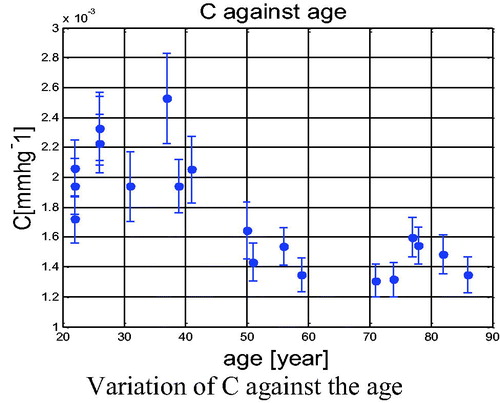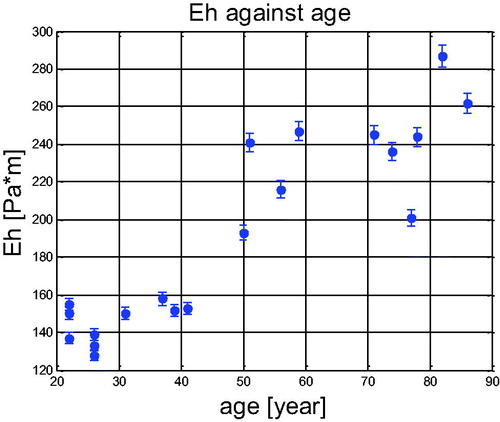 ?Mathematical formulae have been encoded as MathML and are displayed in this HTML version using MathJax in order to improve their display. Uncheck the box to turn MathJax off. This feature requires Javascript. Click on a formula to zoom.
?Mathematical formulae have been encoded as MathML and are displayed in this HTML version using MathJax in order to improve their display. Uncheck the box to turn MathJax off. This feature requires Javascript. Click on a formula to zoom.1. Introduction
Arterial stiffness leads to serious cardiovascular complications, particularly atherosclerosis diabetes and hypertension (Benetos et al. Citation2002; Luo et al. Citation2012). It can be evaluated globally from arterial compliance (C) or intrinsically from Young’s modulus (E). C quantifies the capacity of the artery to distend. It is defined by Chen (Chen et al. Citation2011) as a variation of the radius R of the artery for a given pressure P variation.
Wave speed (c) was expressed in two forms, the first by Moens-Korteweg (Korteweg Citation1878) (EquationEq. (1)(1)
(1) ) and the second by Bramwell Hills (EquationEq. (2)
(2)
(2) ):
(1)
(1)
(2)
(2)
Moens-Korteweg speed is highly related to rheological proprieties of the vessel wall, as Young’s modulus (E), radius (R), the wall thickness (h) and the fluid density ().
Arterial compliance appears in the expression 2 of c:
(3)
(3)
The purpose of this study is to quantify the elastic biomechanical properties of the internal carotid (ICA) wall by applying the cepstral analysis on healthy subjects.
2. Methods
2.1. Study population
Twenty subjects were enrolled in this study (9 males and 11 females): 10 young volunteers having an average age of 29 ± 7 years, and 10 old aged between 50 and 86 years.
2.2. Data acquisition
MRI recordings were performed using a 3 T–machine (dStream, Philips Healthcare, Best, Netherlands). Three-dimensional time of flight cerebral angiogram was determined by sagittal scout images. These acquisitions which measure blood velocity were synchronized with the cardiac cycle. The data were registered with a 2D sequence cine phase-contrast (cine-PC) (Balédent et al. Citation2006).
2.3. The steps to work with our method
The wave speed was calculated by measuring the arrival time of the reflected wave of the blood velocity signal by using cepstral analysis (Ayadi et al. Citation2018). The cepstral analysis is defined as the inverse Fourier transform of the logarithm of the Fourier transform. It allows separating the incident and reflected waves of the blood velocity signal and detecting the arrival time of the reflected waves. If, t01 and t02 are the arrivals times of reflected wave in the two arterial sites at z1 and z2. c was calculated from the following relation (EquationEq. (4)(4)
(4) ):
(4)
(4)
Where Δz = z1–z2 and Δt0=t01–t02.
Through calculated values of c; C and Eh can be estimated via the Bramwell-Hill and Moens-Korteweg EquationEquation (1)(1)
(1) and Equation(2)
(2)
(2) . Indeed, arterial compliance becomes can be expressed as:
(5)
(5)
The wall elastance can be defined as:
(6)
(6)
3. Results and discussion
3.1. Carotid wave speed assessment
Wave speed increased from 5.48 ± 0.29 ms−1 to 6.4 ± 0.4 ms−1 with advancing age and changing genre (Ayadi et al. Citation2018). These findings are agreed with the theoretical results (Borlotti et al. Citation2012).
3.2. Carotid compliance assessment
Arterial compliance values are shown in .
We found that carotid compliance decreased from 15.9 ± 1.5 10−6 Pa−1 (2.1 ± 0.21 10−3 mmHg−1) for young subjects to 10.9 ± 0.97 10−6 Pa−1 (1.4 ± 0.12 10−3 mmHg−1) for older subjects. These results are agree with those obtained by Juonala et al. (Citation2008) and Marlatt et al. (Citation2013).
3.3. Eh assessment
Eh values are displayed in .
The elastance increased from 145 ± 10 KPa for the young group to 237 ± 28 kPa for the old group, which corresponds to an increase of 38%. Accordingly, our approach is sensitive to detect wall elastic properties variation as it is the case with age.
4. Conclusions
The goal of the present study is to estimate noninvasively elastic properties in the internal carotid artery. It suggested a simple and accurate method that can noninvasively determine the wave speed arterial, compliance, and elastance locally in the carotid artery as the function of age and gender. The proposed method presents several advantages over the existing one. It can examine short vessels, which were difficult to access by other approaches.
References
- Ayadi A, Sahtout W, Baledent O. 2018. A new noninvasive method for determining the local (true) wave speed: application to internal carotid artery. Biophys Rev Lett. 1:1–13.
- Balédent O, Gondry-Jouet C, Stoquart-Elsankari S, Bouzerar R, Le Gars D, Meyer ME. 2006. Value of phase contrast magnetic resonance imaging for investigation of cerebral hydrodynamics. J Neuroradiol. 33(5):292–303.
- Benetos A, Waeber B, Izzo J, Mitchell G, Resnick L, Asmar R, Safar M. 2002. Influence of age, risk factors, and cardiovascular and renal disease on arterial stiffness: clinical applications. Am J Hypertens. 15(12):1101–1108.
- Borlotti A, Khir AW, Rietzschel ER, De Buyzere ML, Vermeersch S, Segers P. 2012. Noninvasive determination of local pulse wave velocity and wave intensity: changes with age and gender in the carotid and femoral arteries of healthy human. J Appl Physiol. 113(5):727–735.
- Chen Y, Ding X, Li YL, Zhao XQ, Hu JY. 2011. Experimental models of compliance and young’s modulus of woven vascular prosthesis. AMR. 332–334:609–612.
- Juonala M, Kahonen M, Laitinen T, Hutri-Kahonen N, Jokinen E, Taittonen L, Pietikainen M, Helenius H, Viikari JSA, Raitakari OT. 2008. Effect of age and sex on carotid intima-media thickness, elasticity and brachial endothelial function in healthy adults: the Cardiovascular Risk in Young Finns Study. Eur Heart J. 29(9):1198–1206.
- Korteweg DJ. 1878. Ueber die Fortpflanzungsgeschwindigkeit des Schalles in elastischen Röhren. Ann Phys Chem. 241(12):525–542.
- Luo J, Li RX, Konofagou EE. 2012. Pulse wave imaging of the human carotid artery: an in vivo feasibility study. IEEE Trans Ultrason Ferroelectr Freq Control. 59:174–181.
- Marlatt KL, Kelly AS, Steinberger J, Dengel DR. 2013. The influence of gender on carotid artery compliance and distensibility in children and adults: carotid artery elasticity in youth and adults. J Clin Ultrasound. 41(6):340–346.


